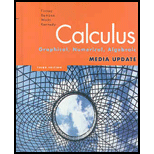
a.
To find the first four terms of the Taylor series and general term of Taylor series generated by
a.
Answer to Problem 58RE
First four terms of series will be 1,
General term will be
Explanation of Solution
Given:
A function
Calculation:
A Taylor series is used to find the value of a function by conditional summation of its derivatives.
For any random function
Here
Here
These coefficients are equal to
To find these coefficients, first the function should be derived 3 to 4 times to develop a pattern so it can be generalized.
This when simplified can be written as
Which can be further simplified as
Now it can be generalized as
And for
Here we get a part of coefficient.
The terms of Taylor series can be written as
Here, it should be noted that 1st term is undifferentiated function at
Value of
Now, the Taylor Series can be written as
For the given question value of
Hence, the first four terms of the Taylor series of the given function will be
1,
And general term will be
Conclusion:
Therefore, first n terms and general term of a Taylor series can be found out by generalizing the derivatives of its function.
b.
To find: the interval of convergence found in part (a).
b.
Answer to Problem 58RE
When
Explanation of Solution
Given:
The series found in part (a) is
Calculation:
To find the interval of convergence, one of the method that can be used is by using the ratio test.
It is done by finding the ratio of
For the series in part (a) .
Thus on dividing two consecutive terms, it comes out as
The series converges when
The answer shows that series converges when
Conclusion:
The ratio test gives
c.
To find
c.
Answer to Problem 58RE
Explanation of Solution
Given:
The series found in part (a) is
Calculation:
Value of
Now for finding adequate terms for error not exceeding for than 1 percent
The 1st term of series of
The 2nd term of series of
The 3rdterm of series of
The 4th term of series of
Thus, it requires minimum 4 terms to get an adequate result with error not more than 1 percent.
The reason is for 1st, 2nd and 3rd terms the answer had recurring values after decimal point, thus the error can exceed more than 1 if 1st three terms are considered.
However, if the 4th term is also considered then the result is obtained where there is a non-recurring value is observed after decimal point.
Conclusion:
Therefore, value of
Chapter 10 Solutions
Calculus: Graphical, Numerical, Algebraic
Additional Math Textbook Solutions
Calculus: Early Transcendentals (2nd Edition)
University Calculus: Early Transcendentals (4th Edition)
Calculus and Its Applications (11th Edition)
University Calculus: Early Transcendentals (3rd Edition)
Calculus: Early Transcendentals (3rd Edition)
 Calculus: Early TranscendentalsCalculusISBN:9781285741550Author:James StewartPublisher:Cengage Learning
Calculus: Early TranscendentalsCalculusISBN:9781285741550Author:James StewartPublisher:Cengage Learning Thomas' Calculus (14th Edition)CalculusISBN:9780134438986Author:Joel R. Hass, Christopher E. Heil, Maurice D. WeirPublisher:PEARSON
Thomas' Calculus (14th Edition)CalculusISBN:9780134438986Author:Joel R. Hass, Christopher E. Heil, Maurice D. WeirPublisher:PEARSON Calculus: Early Transcendentals (3rd Edition)CalculusISBN:9780134763644Author:William L. Briggs, Lyle Cochran, Bernard Gillett, Eric SchulzPublisher:PEARSON
Calculus: Early Transcendentals (3rd Edition)CalculusISBN:9780134763644Author:William L. Briggs, Lyle Cochran, Bernard Gillett, Eric SchulzPublisher:PEARSON Calculus: Early TranscendentalsCalculusISBN:9781319050740Author:Jon Rogawski, Colin Adams, Robert FranzosaPublisher:W. H. Freeman
Calculus: Early TranscendentalsCalculusISBN:9781319050740Author:Jon Rogawski, Colin Adams, Robert FranzosaPublisher:W. H. Freeman
 Calculus: Early Transcendental FunctionsCalculusISBN:9781337552516Author:Ron Larson, Bruce H. EdwardsPublisher:Cengage Learning
Calculus: Early Transcendental FunctionsCalculusISBN:9781337552516Author:Ron Larson, Bruce H. EdwardsPublisher:Cengage Learning





